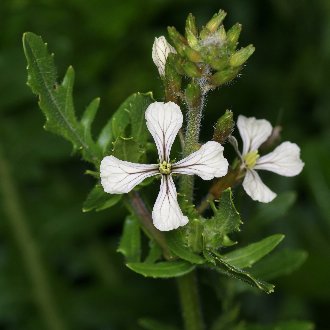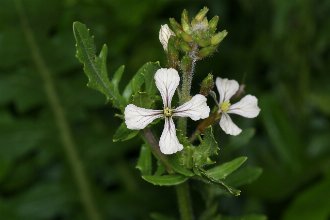Arugula (Eruca sativa Mill.)
Also known as garden rocket, rocketsalad; also classified as Eruca vesicaria subsp. sativa (Mill.) Thell.
Older sources including USDA PLANTS and BONAP refer to this taxon as Eruca vesicaria (L.) Cav., which was formerly treated as a single species with different subspecies. In North America, all established populations were of the taxon treated as Eruca vesicaria ssp. sativa. However, the type specimen Eruca vesicaria (L.) Cav. belongs to the subspecies now treated by POWO as a separate species, native only to Spain, Algeria, and Morocco, and not occurring in North America, and ssp. sativa is separated into its own species. Older sources thus use Eruca vesicaria to refer, in North America, to what we and POWO call Eruca sativa.
↑Range - Expand
| Legend | Color |
| Introduced | |
| Introduced or Not Present |
This map is based on our research. We have checked its accuracy to Level 3 ecoregions. Although this plant occurs somewhere in each of these regions, it may only occur in a small part of some or all of them.
This species is also introduced in Mexico, but we have yet to build this portion of its map.
↑Habitat
This species is widely naturalized across North America. In most regions, it is uncommon and scattered in the wild. However, it is aggressively invasive in the Sonoran Basin and Range and some of the surrounding deserts.
Usually found in full sun, on disturbed sites with exposed soil. Although growth is better on mesic sites with fertile soil, this species is usually more competitive on drier sites. It prefers a soil pH between 6 and 7, growing best around pH 6.8, and tolerating alkaline soil. It usually needs good drainage.
In regions with more humid climates, it is more restricted to anthropogenic habitats, including cropland, roadsides and railroads, and areas near vegetable gardens where this plant has recently escaped cultivation. In drier regions, this species can also occur in natural habitats including rock outcroppings and gravelly slopes.
↑Life Cycle
This species is a cool-season annual with a short lifecycle. It is somewhat opportunistic and can bloom and set seed at different times of year.
Plants usually germinate in fall, winter, or early spring; the foliage is cold-hardy and the plant can often grow through winter.
In the southwest it mostly blooms between December and April, with the timing of both germination and flowering driven mostly by moisture availability. In cooler northerly regions, it usually flowers between April and July, with temperatures more likely to
drive both germination and flowering times. Flowering can continue for 1-2 months with seeds maturing as the plant continues to flower, in favorable conditions, or terminating faster as the plant dies down in drier conditions.
Most seeds germinate in in the second year, but the species forms a short-term seed bank. Viability of seeds decreases rapidly, with only around 20% of seeds remaining viable in the second year, leading this species to persist in the seed bank only 2-3 years in most cases. Seeds are more likely to emerge from a 2-3 year seed bank if there is a lack of disturbance in the first year followed by soil disturbance exposing the seeds in one of the subsequent years.
↑Control
Because this species frequently establishes from garden escapes, it is important to avoid growing it in the southwest in the regions where it is invasive. In the more humid parts of North America, however, it is not invasive and can be grown without issue.
Because it usually requires disturbance to persist, it can be eliminated from many habitats by avoiding soil disturbance in the area for around 5 years, which can cause its soil seed bank to lose viability.
↑Uses
This species has a long history of cultivation as a green vegetable, where it is eaten raw in salads, cooked, or added to sauces. Like many cabbage-family plants, it has a slight peppery flavor, and is highly nutritious, being a good source of vitamins A, C, B9, K, calcium, iron, magnesium, and potassium, and some omega 3.
It is more drought-tolerant than a lot of other widely-cultivated green vegetables. However, this same quality makes this species invasive in desert regions.
↑Notes
We recommend against the use of the term "garden rocket" because it also is used to refer to the plant royal knight's-spur (Delphinium consolida), which is not closely related. We prefer the name "arugula" because it is unambiguous and also clearly communicates that this species is the food plant by that name. In general, the name "rocket" is ambiguous as it is used to refer to many different plants, including other cabbage-family plants as well as plants in other families.
↑Links & External Resources
• Eruca vesicaria (rocketsalad) | USDA PLANTS Database (About This Site)
• Eruca vesicaria | Go Botany (About This Site)
• Eruca vesicaria | Biota of North America Project (BONAP) (About This Site)
• Eruca vesicaria | NatureServe Explorer (About This Site)
• Eruca vesicaria | Flora of North America (About This Site)
• Eruca vesicaria sativa (Garden Rocket) | Illinois Wildflowers (About This Site)
• Rocketsalad | Maryland Biodiversity Project (About This Site)
• Eruca sativa Mill. | Plants of the World Online (POWO) (About This Site)




